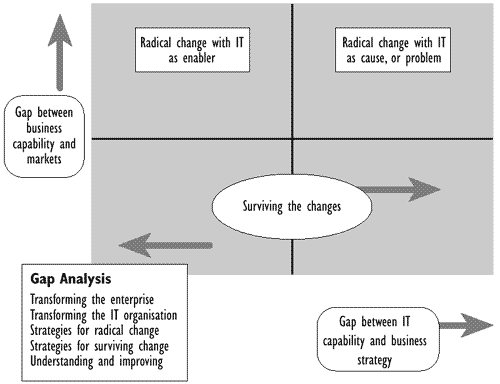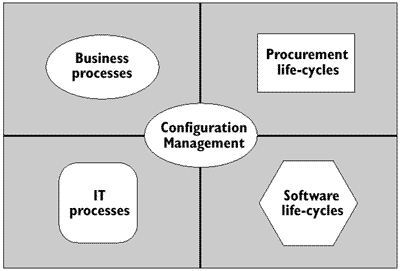Rather than focusing immediately on technology, it is better to consider the role of Change Management in protecting and enhancing critical business processes. Figure 8.6, from the 'Business Perspective' series, illustrates a major dilemma for businesses dependent on IT. Change Management has in the past been associated with the bottom left quadrant of the grid, where business and IT are broadly aligned. Increasingly, IT can cause Change (new technology) or enable Change, all the while increasing business dependence on IT.
As managing Change across the organisation becomes more difficult and as methods to manage programmes and projects emerge and are refined, so must the Change Management processes espoused by BSI, CCTA and others help ameliorate these management issues.

Figure 8.6 - The business perspective on Change
Figure 8.7 represents the four principal components over which we wish to exercise Configuration Management control. John Zachman (an American Configuration Management guru) proposed some years ago that, if IT wished to follow the example of Configuration Management experts such as the aviation and engineering domains, then business and IT processes would have to be defined to an excruciating and hitherto unprecedented level of detail in order to be controlled.

Figure 8.7 - The scope for extending Change Management and Configuration Management control
The influence of Configuration Management (and therefore Change Management) would extend throughout the business and IT domains, providing enormous benefit but also requiring a strategic investment of not inconsiderable dimensions from the business. As a result, it will become increasingly important for Change Management to be fully integrated and influential in the management of major Change. Already we can see investment in methods to manage business Change programmes and projects (PRINCE2 for example).
When the IT Infrastructure Library was first published, the focus for Change Management was to gain control of the increasingly large numbers of IT related Changes, to an extent caused by the rapid growth of technology. Within a few years, business had become dependent on IT to an hitherto unprecedented degree such that the rapid growth of technology was causing major problems for both the business and IT sides of the organisation. Growth of the Internet is a prime example of this. The good news, however, is that principles of Change Management remain unchanged. What has changed is in the need to make processes much more effective and sensitive to the rapid pace of business and technology change).
Software tools support has evolved rapidly to accommodate some of the issues of sensitivity and effectiveness. A number of vendors provide tools that operate in an Internet environment, with remote updating of central databases. As the World Wide Web and the Internet have improved access to information and enabled both business and IT to expand their sphere of influence, security of data has become much more of a problem. This has lead to an increase of responsibility of Change Managers for assessing the impact of Changes on security and finding themselves in need of guidance (see ITIL Security Management - ISBN 0-11-330014-X).
Another area in which Change Management is beginning to influence is applications software development and requirement specification. The impact of new applications running in a live environment has been an issue for ITIL-trained personnel for many years. However, their role in the development life-cycle was largely unknown - although the ITIL book Software Lifecycle Support (ISBN 0-11-330559-1) was published to cover the problem, the issue was not high enough on the agenda of the service providers and therefore was largely ignored until recently.
The major activities of Release Management are defined in the Change life-cycle; as with software maintenance, the technical concepts of an often ignored process (or perhaps a process that is difficult to describe in terms of importance to the business) can be seen to be of particular importance to those in the front line of Service Management. This is illustrated in Figure 9.1 in the Release Management chapter of this guide.
As proper Configuration Management controls are extended to applications software development, so the influence of Change Management has spread to the requirements specification. Requirements specifications now (should!) take into account infrastructure management issues at the design stage. By so doing, infrastructure management not only improves the chances of smooth live operations of new applications, but also reduces the problem of maintenance (and maintenance of software has been proven to cost many many times more than the cost of development).